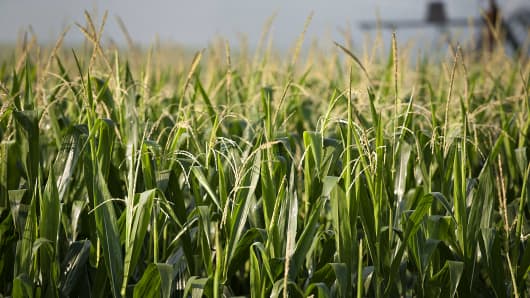The spring weather pattern looks greatly improved from a year ago, when drought was both widespread and severe—good news for agricultural producers, a private weather forecaster said on Wednesday.
A series of winter storms, which have continued into March, add up to a more positive outlook for crops that will be planted from the Plains to the East Coast, AccuWeather said in its 2013 spring weather outlook.
"A bumper crop of corn alone later this summer could eventually reduce the pressure on grain, livestock feed and other consumer prices," said AccuWeather, which is based in State College, Pa.
(Read More: Drought Plagues US: Food Prices 'Going Up')
"Compared to last year, for the season as a whole, more moisture will be available for agriculture due to lower temperatures and lower evaporation rates from the Mississippi Valley to much of the Atlantic coastal plain," the outlook stated.
The Agriculture Department has projected record-large corn and soybean crops this year, assuming normal growing conditions. New-crop futures at the CBOT are trading well below those of old crops in anticipation of bumper harvests.
"We expect ample moisture during most of the growing season with few exceptions into this summer, from the Mississippi Valley to the East Coast," said Paul Pastelok, head of AccuWeather's long-range forecasting department.
Echoing a recent government forecast, AccuWeather said that parts of California and the Florida peninsula could have drought or at least drier-than-normal conditions into the first part of the summer.
"A lack of big snowstorms over the Sierra Nevada and other ranges in the West could mean water resource limitations in California," the company said.
Overall, though, the severe drought that extended over much of the country last year and hammered corn, soybean and wheat growers is not expected to be repeated.
(Read More: Snowfall Too Light to Ease Drought in US Crop Belt)
Winter storms have added up to near-normal snowfall for major cropping areas of the lower Plains through the Midwest and in parts of the Northwest, AccuWeather said.
Average temperatures are also significantly lower this March from a year ago, which will result in lower evaporation rates for a time.
"Overall, less long-lasting, extreme heat is forecast from the Mississippi Valley to the East during most of the spring and summer," the group said.
One negative of cooler spring temperatures is that crops generally could be planted later this year, limiting the opportunity for double-cropping, said Dale Mohler, an agricultural weather specialist with the firm.


